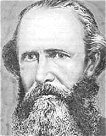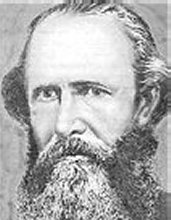
R.T. Trall M.D. (1812-1877)
[back] Natural Healers
[Russell Thacker Trall (1812-1877) Russell Thacker Trall, medical practitioner, educator and writer, was a dynamic pioneer of hydrotherapy and natural hygiene. Born the son of a Connecticut farmer, he completed a medical degree and opened a water-cure house in New York City in 1844, where he demonstrated his alternative to modern medicine's drug treatments. His institute was a cross between an urban health farm and a boarding house, offering plain vegetarian meals, hydrotherapy treatments, a gymnasium, public rooms and, starting in the 1860s, a health food shop selling whole grains, cereals, Graham bread (Trall was a friend of Graham), and his books on food reform, hygiene, sex and physiology. In 1853, Trall established the New York Hydropathic School. Here he taught that mainstream medicine required a revolution--a vision of health as an active state to be positively achieved by methods learned from nature. His students learned water treatment and nutrition, the virtues of self-discipline and emotional, sexual and physical moderation, as well as procedures like mesmerism and magnetism. Trall was one of the strongest proponents of water cure, but in time he became critical of the excesses which sometimes marked hydropathic treatments. Significantly, the school was renamed the New York Hygieo-Therapeutic College when it was chartered in 1957. The word "hygienic" came to replace "hydropathic" in Trall's characterization of his alternative medicine. He wrote a definitive description of the philosophy and methods of his school in a small book called The Hygienic System. Trall wrote over forty books, the most ambitious being the Hydropathic Encyclopedia. He edited several reviews including the Water Cure Journal, later called the Herald of Health, to which he was by far the most prolific contributor. 1 ]
[1862] THE TRUE HEALING ART Or, HYGIENIC vs. DRUG MEDICATION--R.T. Trall
M.D.
"Trall's talk is one of the first cogent, consistent statements of the hygienic viewpoint." ---Soil and Health Library
"Dr. Russell T. Trall, the eminent Natural Hygienist, considered smallpox "as essentially . . . not a dangerous disease." He cared for large numbers of patients afflicted with smallpox and never lost a case."--Dr Shelton DC http://www.whale.to/vaccine/shelton.html
"I have myself, through Natural Hygiene, over 16 years, treated all forms and hundreds of cases of typhus and typhoid fevers, pneumonia's, measles and dysentery's, and have not lost a single patient. The same is true of scarlet and other fevers. No medicine whatever was given."----Dr Trall, 1862.
"These diseases (typhoid and pneumonia) are nothing more nor less than a cleansing process - a struggle of the vital powers to relieve the system of its accumulated impurities. The causes of the diseases are constipating foods, contaminated water, atmospheric miasmas, and whatever clogs up the system or befouls the blood. And the day is not far distant when a physician who shall undertake to aid and assist (suppress) Nature in her efforts to expel impurities, by the administration of poisons (drugs, medicines, shots, radiation, etc.) will be regarded as an insane idiot. But now this practice is called medical science."----Trall
''The Drug Medical System cannot bear examination. To explain it would be to destroy it, and to defend it even is to damage it."---R.T. Trall M.D.
"Last year a patient came to me with both arms paralyzed. Three months before he had, acute rheumatism--a disease I have treated scores of cases of, and never failed to cure within two weeks--for which his physician prescribed mercury, antimony, colchicum, and potassium hydroxide. The drugs had cured the rheumatism, but ruined the patient. And what do you suppose his physician proposed to "try" next? Why, strychnine, of course!"---Dr Trall, 1862.
"Four years ago, the young man--he was a youth then, and of excellent constitution--had lung fever. His physician reduced his fever and his vitality with powerful doses of antimony, and kept blisters on the chest continually. In two weeks he appeared to be convalescent, but soon relapsed, when calomel was given in large doses. And lingering several weeks, the disease was said to have run into the typhoid, for which more calomel was prescribed. The fever next assumed the intermittent form, attended with profuse sweating, for which iron and quinine were liberally administered. He was drugged continually for six months, when it was discovered that the liver and spleen were badly congested and enlarged, and he was put on a course of mercury in a new shape--blue-pill mass. After this the disease assumed many complications, as well it might, for which a promiscuous medley of medicaments were prescribed for two years longer, among which was hellebore, irritating plasters, several kinds of pills, and a variety of homeopathic pellets and placebos."--R.T. Trall M.D. (1862)
"Five years ago he had the ague, for which he took quinine in huge dozes. This treatment so paralyzed the functions of the liver that it became greatly congested and enlarged; for which mercury was prescribed. The mercury induced chronic inflammation of the duodenum--mercurial duodenitis --for which antimony and opium were administered. These drugs extended the inflammation to the kidneys, prostrated the external circulation, and torpified the action of the skin; for which more mercury, in the shape of blue-pill, with narcotics, was given. These remedies so exhausted the vital energies, that the next phase of disease was termed "nervous debility," and then strychnine was prescribed. After the nervous debility had been sufficiently cured with strychnine, the doctors diagnosed "spinal disease," and proceeded to blister and cauterize the back. Lastly, neuralgia "set in," and the doctors resorted to henbane."--R.T. Trall M.D. (1862)


